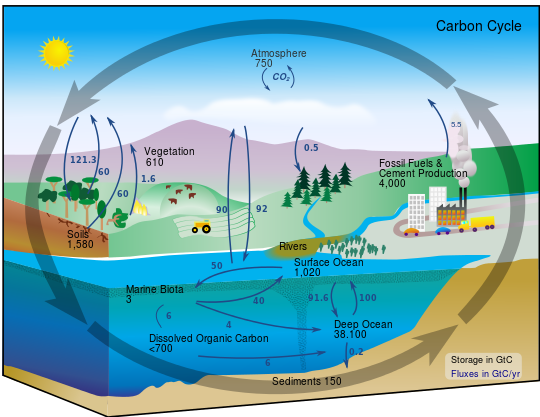Sumi Vora
AP Environmental Science ♻️
252 resourcesSee Units
Movement of Matter
The earth is a closed system, which means matter can never be removed or created. Instead, matter moves across the earth in cycles called biogeochemical cycles. These cycles rely on essential earth elements and interactions between species and nature to use and reuse various materials. These basic cycles are essential for supporting life on Earth, but when they are disrupted, it can cause matter to get “stuck” or move too quickly between stages. AP Environmental Science focuses on these cycles in Unit One to explain more complex phenomena and help understand how, at the core, these are scientific processes essential to understanding the environment.
Carbon Cycle 🌋
The carbon cycle is the movement of carbon across the earth. It details the process by which carbon is exchanged between the Earth's atmosphere, land, and oceans. Carbon is a vital element that is essential for life on Earth, and the carbon cycle plays a crucial role in regulating the amount of carbon dioxide (CO2) in the atmosphere.
The carbon has two stages: the fast stage, which is associated with living organisms, and the slow stage, which is associated with dead organisms (fossil carbons). However, there are also mini-cycles within it.

Image Courtesy of Wikimedia Commons
The first mini-cycle occurs on land. As seen above, plants intake CO2 and convert it to oxygen in a process known as photosynthesis. When photosynthesis occurs, CO2 from human activity and other natural processes is regulated and converted to oxygen, essential for the Earth's health and human survival. Since CO2 is a greenhouse gas, preventing its overabundance is important so as to mitigate the effects of climate change. When plants carry out photosynthesis, they retain a small amount of CO2 through cellular respiration, which produces energy by converting glucose into ATP. This allows for plants to maintain function of their cells and natural processes. Mostly, though, photosynthesis produces oxygen, another key element in Earth's composition that accounts for human survival and other essential environmental functions. The CO2 that plants retain is kept in their plant tissue, which eventually dies (or is consumed by a predator who will also eventually die). Them a species called a decomposer will process that matter, leaving all carbon in the soil or nearby surroundings. The carbon cycle will continue to occur, recycling carbon through Earth's atmosphere. Large reservoirs of carbon, such as oceans or landfills, are called carbon sinks, and help to retain and mitigate large amounts of carbon through storage.
There are two mini-cycles that take place in the ocean.
The first process that occurs in the ocean is carbon exchange: the ocean absorbs some CO2 from the atmosphere, and it releases roughly the same amount of CO2 back into the atmosphere.
The second process that occurs in the ocean is sedimentation. The CO2 combines with calcium ions in the water to form calcium carbonate, which sinks to the bottom of the ocean and accumulates. If left undisturbed, it can cause accumulation of carbon, but upon disturbance that carbon is reintroduced to the atmosphere and continues its journey through the carbon cycle.
Without human contribution, carbon deposits into earth's soil was roughly equal to carbon that had been released into the atmosphere. Though, with the extraction of fossil fuels becoming common and contributing to climate change, this proportion is altered. At the end of these cycles, carbon will either remain in the atmosphere or accumulate as a fossil fuel.
Human Impacts on the Carbon Cycle 🙌
Human discoveries regarding the usability of fossil fuels in industry has led to overuse and over-extraction. Carbon's reentry into earth's soils and ground is happening at a much slower rate than our harvesting of it as a fossil fuel. This means two things: 1. we will eventually run out of fossil fuels, as they are a nonrenewable form of energy, and 2. that carbon's presence in the atmosphere is very oversaturated, which contributes greatly to climate change.
Additionally, due to deforestation and declines in agricultural industry, fewer plants and crops exist to actually process carbon through photosynthesis. Thus, we are left with more CO2 than needed, since dead plants are not able to photosynthesize it into oxygen. Global warming is exacerbated by this phenomenon.
Browse Study Guides By Unit
🏜Unit 1 – The Living World: Ecosystems
🐠Unit 2 – The Living World: Biodiversity
👪Unit 3 – Populations
🌏Unit 4 – Earth Systems & Resources
🏖Unit 5 – Land & Water Use
⚡️Unit 6 – Energy Resources & Consumption
💨Unit 7 – Atmospheric Pollution
♻️Unit 8 – Aquatic & Terrestrial Pollution
🔥Unit 9 – Global Change
📚Study Tools
🤔Exam Skills

Fiveable
Resources
© 2025 Fiveable Inc. All rights reserved.